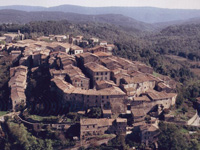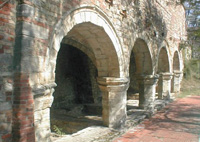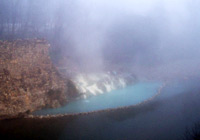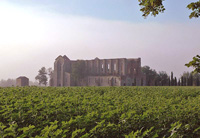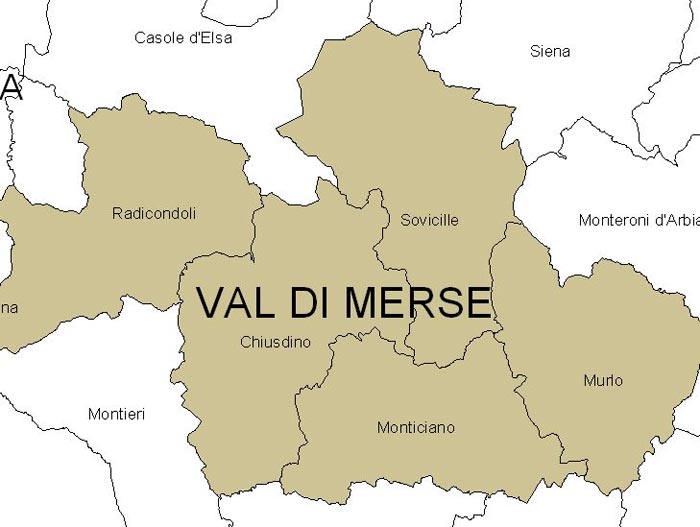
Val di Merse |
Val di Merse is one of the regions of the province of Siena, in Tuscany. It is located on the border with the Upper Maremma and it is renowned for its unspoilt nature. The territory comprises the area between the rivers Farma and Merse and it is covered in woods which hide medieval hamlets and castles. It is an area rich in waters known for their healing powers, such as the hot springs of Bagni di Petriolo. |
Monticiano
|
||||
| Monticiano is a very old village which dates back to the 12th century. Originally a castle property of the Bishop of Volterra, it later came under the domination of Siena. The remains of the castle are still visible and the little streets of the village are very picturesque. The village has two churches, the Romanesque church of Sant'Agostino of the late 13th century, with baroque interiors, and the older parish, the church of San Giusto and San Clemente, of the 12th century, with a neat stone façade.
The village is located in a beautiful area, in the heart of a valley between the river Merse and the river Farma, approximately 30km from Siena, 100km from Florence and 150km from Pisa. It has less than 1500 inhabitants and all the essential services are available in town (pharmacy, clinics, post office, banks, shops, restaurants and bars). The village will soon have a public swimming pool right by Casa Gigliola: it is scheduled to open at the beginning of 2007. It has children's playgrounds, horseback riding facilities and walking trails. The village and its surroundings, despite being very conveniently located at a crossroad between the Maremma and Siena, are still an off-the-beaten path destination. For this reason, they make for a perfect location to discover authentic Tuscany far from the crowds. The oldest part of the village is located on a hilltop, within the remains of the ancient walls. From the top of the hill the view over the valley of the river Merse is breathtaking. The atmosphere among the walls of the village is definitely medieval: stone houses, small parish churches, narrow streets. The origins of the village are celebrated every year in October, when the Palio dei Ciuchi, a donkey race in medieval costumes, brings the past back to life.
|
|
|||
|
|
||||
 |
 |
 |
||
Le terme medievali e la soprastante chiesetta, entrambe di origine medievale
|
Bagni di Petriolo, Monticiano |
Rovine delle mura cittadine di Bagni di Petriolo, Monticiano | ||
|
||||
 |
 |
 |
||
San Lorenzo a Merse
|
San Lorenzo a Merse, veduta | San Lorenzo a Merse, panorama | ||
 |
 |
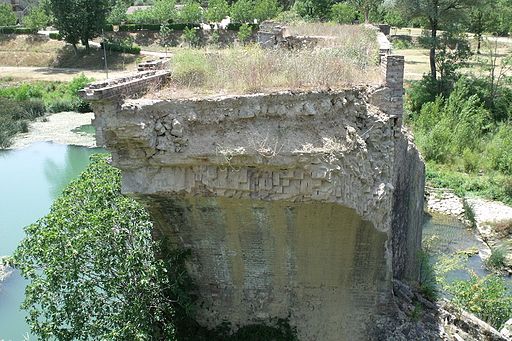 |
||
San Lorenzo a Merse, campanili
|
Ponte a Macereto | Ponte a Macereto | ||
 |
 |
 |
||
Pieve di San Lorenzo a Merse
|
Pieve di San Lorenzo a Merse, facciata
|
Pieve di San Lorenzo a Merse | ||
Going back in time is very easy in this part of Tuscany: the Abbey of San Galgano with the legendary sword in the stone, the near village of San Lorenzo a Merse with its ancient castle and its Romanesque church, the hamlet of Castello di Tocchi, the ruins of the Castellaccio, of Monte Quoio and Renna make this journey in time very easy.
|
||||
| San Galgano Abbey is made up of two major attractions: the gothic roofless cathedral of San Galgano and the unusually shaped monastery of Montesiepi, and ancient hermitage, which hosts the tomb of San Galgano and the sword in the stone.[1] Saint Galgano Abbey was Tuscany's first pure Gothic church. It was built in the 13th century when the old chapel and monastery became too small for the pilgrims who visited the tomb of the saint from Siena. The abbey is built according to the typical Cistercian plan based on a Latin cross with three aisles, rich in carved capitals and rose windows, with a cloister, halls, and – atypically – a bell tower. Over the centuries the rivalries between Siena and Florence condemned the abbey to a slow but irreversible decline, and at the end of the 18th century the bell tower collapsed destroying a great part of the roof of the church. The abbey was abandoned and the bricks and stones were used by the builders of the area to build houses and other small churches. Thanks to several restorations the cathedral is now one of the most beautiful and fascinating ruins in Tuscany, and it is well worth a visit. Many legends have been created to account for the absence of the roof. One of the most popular among the poor farmers of the Val di Merse was that Napoleon had stolen the supposedly golden roof of the cathedral. San Galgano Abbey is easily reached from Monticiano with a short 5 minutes drive, or via the walking trail which has been recently created. |
|
|||
|
|
|
 |
Podere Santa Pia is a peaceful retreat, perfect for relaxing with a magnificent panoramic view of the Mediterranean Sea
|
| [1] The legend of Saint Galgano
Galgano Guidotti was a dissolute knight who lived in Chiusdino in the second half of the 12th century. The Archangel Michael appeared to him one day, convinced him to repent and showed him the way to salvation. Sir Galgano announced his intention to become a hermit and live in a cave, but his friends and family made fun of him. His mother Dionisia convinced him to wear his noble robes and go to Civitella Marittima to see his fiancée Polissena Brizzi for the last time but along the way Sir Galgano's horse reared and the knight fell. He suddenly felt some force helping him to get back on his feet. The knight heard a seraphic voice which he was unable to resist and this led him to Monte Siepi, a rugged hill near Chiusdino. There he had the vision of a round temple and of Jesus and the Holy Virgin Mary with the Apostles. The voice guided Sir Galgano to the top of the hill and invited him to give up his sinful life but the knight was hesitant and wittily replied that, even if he thought he should indeed change his life, changing would be as hard as splitting rocks with his sword and in saying this, he drew his weapon and thrust at a stone, fully expecting the blade to snap. To his great surprise, the sword cut the stone and entered into the rock to the hilt. Sir Galgano did not leave the hill ever again. He lived in poverty, with wild animals as his only companions. The legend says that the Devil sent an evil man in a monk's disguise to murder Galgano but the wolves that lived with him tore the man to pieces, leaving only his hands. The sword in the stone and the hands of the evil man can still be seen in the church of the monastery of Montesiepi, built at the end of the 12th century as a mausoleum for the saint. Saint Galgano is buried in the church. The church has a very peculiar shape, it is built as a rotunda and historians hypothesize that it was inspired by Castel Sant'Angelo, the Pantheon in Rome or even an Etruscan tomb as the many ones visible in Volterra, the town that once controlled this area. The church was enlarged in the 14th century with the construction of a chapel with frescoes by the Sienese painter Ambrogio Lorenzetti. Over the centuries the sword in the stone and its legend have fascinated pilgrims and visitors from around the world. The many resemblances to the tales of the Arthurian cycle has probably not gone unnoticed. Many scholars have pointed out the striking resemblance of the name of the saint, Galgano, with that of one of the knights of the Round Table, Sir Galwyn, who, by the way, was of Roman origin. Other scholars have insisted on the resemblance to the youngest of King Arthur's knights: Sir Gawain. Of course, the sword in the stone is associated with Excalibur and a recent book by the writer Mario Moiraghi, The Enigma of San Galgano, proposes an interesting explanation for all these coincidences. The author claims that the story of the sword in the stone originated in Tuscany, in Italy and not in the Celtic fringes of Britain or in France as many believe and that it was added to the legend of King Arthur later on. Moiraghi supports his hypothesis with scientific tests which date the sword embedded in the rock in an abbey in Tuscany to the year 1180, years before the first attested literary reference to the sword in the Arthurian Cycle. The author also stresses how the inquiry which led to the canonisation of Sir Galgano contains a series of facts identical to the legend of Sir Percival, the finder of the Holy Grail. If these hypotheses are true, then the legend of Excalibur could have originated in Tuscany, and have been exported to France by the Cistercian monks, whose responsibility in the diffusion of King Arthur's legends is widely acknowledged. Moreover the Abbey and the chapel dedicated to Saint Galgano and King Arthur's tomb in Glastonbury date back to the same period and this offers yet another link between this magic place in Tuscany and the most legendary of all kings.
|

